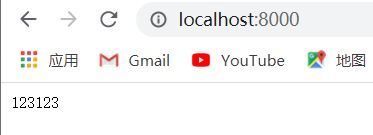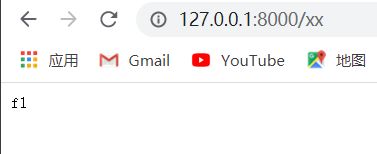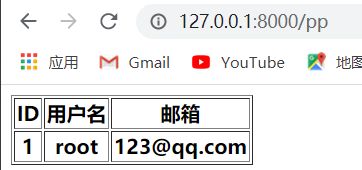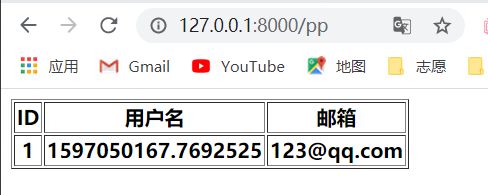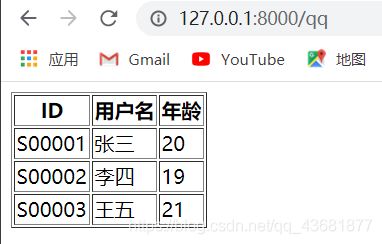自己开发Web框架(Python版)
根据课程所做笔记
源码已整理上传网盘
链接:https://pan.baidu.com/s/1pn_dFJ1W67nP_BfkQM9CQQ
提取码:bsyh
1 计算机网络简单知识
- HTTP:
无状态、短链接 - TCP:
不断开 - WEB应用:
socket客户端(浏览器):
② DNS解析域名
socket连接
发送socket请求
⑤ 接收
⑥ 连接断开
socket服务端:
①监听端口
while True:
等待用户连接
③ 收到客户端请求
④ 响应请求
用户断开
2 简单socket编程
2.1 简单原理版
import socket
# 创建socket对象
sock = socket.socket()
# 绑定ip以及端口
sock.bind(('127.0.0.1',8000))
# listen()方法开始监听端口,传入参数指定等待连接的最大数量为5
sock.listen(5)
# 接下来服务器程序通过一个永久循环来接受来自客户端的链接
while True:
# 接收一个新的连接
conn, addr = sock.accept()
# 获取用户数据
data = conn.recv(8096)
# 回复
# 响应头
conn.send(b'HTTP/1.1 200 OK\r\n\r\n')
# 响应体
conn.send(b'123123')
# 关闭连接
conn.close()
b'
GET / HTTP/1.1
Host: localhost:8000
Connection: keep-alive
nCache-Control: max-age=0
nUpgrade-Insecure-Reques
ts: 1
User-Agent: Mozilla/5.0 (Windows NT 10.0; Win64; x64) AppleWebKit/537.36 (KHTML, like Gecko) Chrome/83.0.4103.106 Safari/537.36
Accept: text/html,application/xhtml+xml,application/xml;q=0.9,image/webp,image/apng,*/*;q=0.8,application/signed-exchange;v=b3;q=0.9
nSec-Fetch-Site: none
Sec-Fetch-Mode: navigate
Sec-Fetch-User: ?1
Sec-Fetch-Des
t: document
Accept-Encoding: gzip, deflate, br
Accept-Language: zh-CN,zh;q=0.9
Cookie: Goland-c22efa88=68593b8d-368e-4b39-b1f4-679ef9cad0a6; Pycharm-36d26765=cd37937e-64cc-47aa-9140-316446d8daaa; Pycharm-42af32e2=c9e5711c-4162-4d82-b
1ed-a9fc0d81d8d4
'
2.2 简单添加路由版
由于访问路径一般在请求头的访问方法之后,故可以将请求头进行切割获得访问路径。
![]()
import socket
# 创建socket对象
sock = socket.socket()
# 绑定ip以及端口
sock.bind(('127.0.0.1',8000))
# listen()方法开始监听端口,传入参数指定等待连接的最大数量为5
sock.listen(5)
# 接下来服务器程序通过一个永久循环来接受来自客户端的链接
while True:
# 接收一个新的连接
conn, addr = sock.accept()
# 获取用户数据
data = conn.recv(8096)
# 快速将data的b类型转换为str类型
data = str(data, encoding='utf-8')
# 分割请求头和请求体
headers, bodies = data.split('\r\n\r\n')
# 获取第一行
temp_list = headers.split('\r\n')
# 获得请求路径
method,url,protocal = temp_list[0].split(" ")
# 回复
# 响应头
conn.send(b'HTTP/1.1 200 OK\r\n\r\n')
if url == '/xx':
# 响应体
conn.send(b'123123')
else:
conn.send(b'404 not found')
# 关闭连接
conn.close()
2.3 进阶结构化版
import socket
# 处理路由函数
def f1(request):
'''
处理请求,并返回相应内容
:param request: 用户请求的信息
:return:
'''
return b"f1"
def f2(request):
return b"f2"
# 路由列表
routers = [
('/xx', f1),
('/pp', f2),
]
# 创建socket对象
sock = socket.socket()
# 绑定ip以及端口
sock.bind(('127.0.0.1', 8000))
# listen()方法开始监听端口,传入参数指定等待连接的最大数量为5
sock.listen(5)
# 接下来服务器程序通过一个永久循环来接受来自客户端的链接
while True:
# 接收一个新的连接
conn, addr = sock.accept()
# 获取用户数据
data = conn.recv(8096)
# 快速将data的b类型转换为str类型
data = str(data, encoding='utf-8')
# 分割请求头和请求体
headers, bodies = data.split('\r\n\r\n')
# 获取第一行
temp_list = headers.split('\r\n')
# 获得请求路径
method, url, protocal = temp_list[0].split(" ")
# 回复
# 响应头
conn.send(b'HTTP/1.1 200 OK\r\n\r\n')
func_name = None
for router in routers:
if router[0] == url:
func_name = router[1]
break
if func_name:
response = func_name(data)
else:
response = b"404"
# 返回响应
conn.send(response)
# 关闭连接
conn.close()
if __name__ == "__main__":
run()
访问结果
2.4 进阶HTML版
<html lang="en">
<head>
<meta charset="UTF-8">
<title>Indextitle>
head>
<body>
<h1>用户登录h1>
<form>
<p><input type="text" placeholder="用户名"/>p>
<p><input type="password" placeholder="密码"/>p>
form>
body>
html>
将路由函数修改为:
# 处理路由函数
def f1(request):
'''
处理请求,并返回相应内容
:param request: 用户请求的信息
:return:
'''
f = open("index.html",'rb')
data = f.read()
f.close()
return data
<html lang="en">
<head>
<meta charset="UTF-8">
<title>Aricletitle>
head>
<body>
<table border="1">
<thead>
<tr>
<th>IDth>
<th>用户名th>
<th>邮箱th>
tr>
thead>
<tbody>
<tr>
<th>1th>
<th>rootth>
<th>[email protected]th>
tr>
tbody>
table>
body>
html>
修改f2()函数
def f2(request):
f = open("article.html",'rb')
data = f.read()
f.close()
return data
访问结果:

但是上面案例为静态网站,下面来连接数据库成为动态网站
2.5 进阶版简单模板
修改article HTML文件为:
<html lang="en">
<head>
<meta charset="UTF-8">
<title>Aricletitle>
head>
<body>
<table border="1">
<thead>
<tr>
<th>IDth>
<th>用户名th>
<th>邮箱th>
tr>
thead>
<tbody>
<tr>
<th>1th>
<th>@@sw@@th>
<th>[email protected]th>
tr>
tbody>
table>
body>
html>
替换HTML中@@sw@@
def f2(request):
f = open("article.html", 'r', encoding='utf-8')
data = f.read()
import time
ctime = time.time() #现在就可以动态变化
data = data.replace('@@sw@@', str(ctime))
f.close()
return bytes(data, encoding='utf-8')
2.6 进阶连接数据库版
新建html文件 userlist.html
<html lang="en">
<head>
<meta charset="UTF-8">
<title>Aricletitle>
head>
<body>
<table border="1">
<thead>
<tr>
<th>IDth>
<th>用户名th>
<th>年龄th>
tr>
thead>
<tbody>
@@shd@@
tbody>
table>
body>
html>
新增 f3()
def f3(request):
import pymysql
# 操作mysql
# 创建连接
conn = pymysql.connect(host='127.0.0.1', port=3306, user='root', passwd='xxxxxx', db='test03')
# 创建游标
cursor = conn.cursor(cursor=pymysql.cursors.DictCursor)
cursor.execute("select SNO,Name,Age from student")
user_list = cursor.fetchall()
# 关闭游标
cursor.close()
# 关闭连接
conn.close()
# print(user_list)
content_list = []
for row in user_list:
template = "%s %s %s 数据库查询的user如下(user_list)
[{'SNO': 'S00001', 'Name': '张三', 'Age': 20},
{'SNO': 'S00002', 'Name': '李四', 'Age': 19},
{'SNO': 'S00003', 'Name': '王五', 'Age': 21}]
替换的内容如下:
['S00001 张三 20 S00002 李四 19 S00003 王五 21 2.7 使用jinja2进行模板渲染
host_list.html
<html lang="en">
<head>
<meta charset="UTF-8">
<title>HostListtitle>
head>
<body>
<table border="1">
<thead>
<tr>
<th>IDth>
<th>用户名th>
<th>年龄th>
tr>
thead>
<tbody>
{% for row in host_list %}
<tr>
<td>{{row.SNO}}td>
<td>{{row.Name}}td>
<td>{{row.Age}}td>
tr>
{% endfor %}
tbody>
table>
body>
html>
编写 f4()
def f4(request):
import pymysql
# 创建连接
conn = pymysql.connect(host='127.0.0.1', port=3306, user='root', passwd='liaojiaxin68', db='test03')
# 创建游标
cursor = conn.cursor(cursor=pymysql.cursors.DictCursor)
cursor.execute("select SNO,Name,Age from student")
user_list = cursor.fetchall()
# 关闭游标
cursor.close()
# 关闭连接
conn.close()
f = open('hostlist.html', 'r', encoding='utf-8')
data = f.read()
f.close()
from jinja2 import Template
template = Template(data)
# render 进行渲染 使用jinja规则 用这里的user_list替换html中的host_list
data = template.render(host_list=user_list)
return data.encode('utf-8')
3 总结
- socket 服务器
- 根据URL不同路径返回不同内容
路由系统:
URL——>函数 - 字符串返回给用户
模板引擎渲染:
1.HTML自己充当模板(特殊字符)
2.自己创造任意数据
字符串 - WEB框架
1.框架种类:
-a,b,c ——>Tonado
-[第三方a]b,c (Ngix其实是一个Socket服务端) ——>wsgiref ——>Django
-[第三方a],b,[第三方c] wsgiref …——>flask——>jinja2
2.分类
-Django框架(Web…)
-其他
